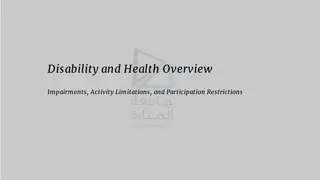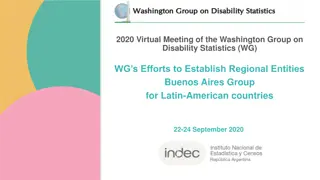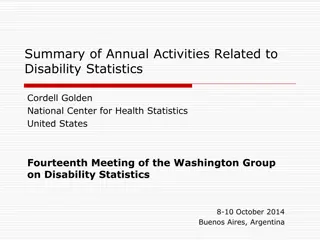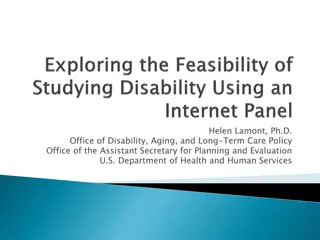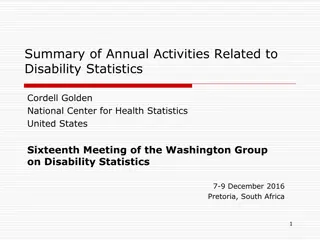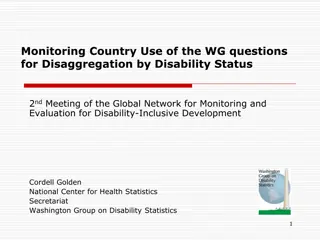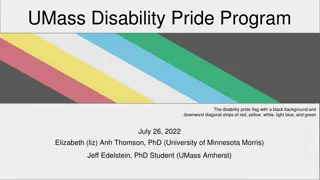Understanding Disability Measurement and Environmental Factors
The 15th Meeting of the Washington Group on Disability Statistics highlighted the importance of measuring disability by considering both the individual's capacity and the environmental factors that impact participation. The lived experience of individuals with disabilities must be understood to facilitate their inclusion in society. Capturing information about the environment and identifying barriers and supports are crucial in this process.
Download Presentation

Please find below an Image/Link to download the presentation.
The content on the website is provided AS IS for your information and personal use only. It may not be sold, licensed, or shared on other websites without obtaining consent from the author. Download presentation by click this link. If you encounter any issues during the download, it is possible that the publisher has removed the file from their server.
E N D
Presentation Transcript
15thMeeting of the Washington Group on Disability Statistics Copenhagen, Denmark 27-29 October 2015
The measurement of disability requires: Person Environment Person: identify those at risk of participation limitations Measure the person s capacity using the SS-F & ES-F. Environment: identify the contextual factors in which participation occurs Both the supports and barriers are necessary.
A major objective is to understand the lived experience of persons with limitations and to facilitate their inclusion in society in the way that they would choose for themselves. The impact of environment on that experience has not been adequately explored because we lack measures of the environment. We have missed an important part of the disability equation by not accounting for environmental barriers and supports in our data. Therefore the original purpose of discussion of environmental measurement was to identify a way to include related environmental facilitators and barriers that most prominently support or prevent participation.
Person Only a person can enact a specific activity. Action or Activity Participation involves many different activities in a variety of domains. The individual chooses to act or not and also which activities are most important for them. Context The immediate environment where activity takes place and the other people involved can contribute to or inhibit the actor s participation.
Cultural Context Environment Activity / Action Person / Choice Type of Risk (limitations) +/- Environmental factors (barriers/supports) contributes to Outcomes of Activity
Directly capture information about the environment in which participation occurs. Measure the environment independently of the person. Obtain information about the general environment on common or universal characteristics.
Which environment? Legal, cultural, built, natural, technical, attitudinal Cultures vary on way things are done and who can do them Natural environments differ influencing the structure of built environments Which location in an environment? Home, work, school, community, social group Different activities take place in very different environments Other factors influencing impact of environment include person s age, gender, ethnicity, income
There is no one, standard environment. It is almost impossible to separate the environment from the individual s participation in fulfilling social, family and work activities.
Indirectly capture information about the environment in which participation occurs. Consider the particular domains of participation in which activities occur. Measure the environment through the person s participation in these activities. Obtain information about activity-specific environmental supports and barriers.
Participation encompasses numerous types of actions, all of which vary by socio-demographic characteristics. What are the most common, universal types of participation? What activities occur, or are necessary, to full participation? Can we chose activities that are performed in commonplace ways or contexts?
Domain 1 Domain 2 Domain 3 Domain 4 Domain 5 A1 A1 A1 A1 A1 A2 A2 A2 A2 A2 A3 A3 A3 A3 A3 A4 A4 A4 A4 A4
School Work Family Civic Social Meeting/ interacting with friends or neighbors Attending civic meetings or gatherings Cooking or meal preparation Getting to school Getting to work Attending sports events, movies or concerts Using learning materials Shopping for food or HH items Voting or political activities Applying for work Class or after school activities Using equipment at work Attending religious activities Visiting museums, libraries or parks Child care Successful completion of school Attending work meetings or training Charitable activities or volunteering Travel or going to restaurants Household tasks
Distinguishing based on choice An equally difficult separation that needs to be made is whether a person chooses to or chooses not to perform a specific activity in the available environment. What is the difference between choosing not to do an action or being unable to do the action (environmental barrier)? How is such a differentiation in participation knowable? How do we capture exogenous choice the individual s choice independent of the environment?
Within cultural context the freedom or restriction of choices for specific individuals. Does person qualify to perform the action in the cultural context? Within specific legitimate roles the range of acceptable behavioral choices. Differences in flexibility of family type of activities compared to more formal activities in a business setting. Other factors contribute or restrict choice as well. Age Gender
Some participation / activities are more structured than others or seen as more central than others. Self-care expectation that one will wash and dress daily Family roles such as childcare expectation that children will be fed, clothed, supervised School for children, work for adults expectation that these are necessary daily activities Social activities are more varied and flexible; take place in less formal situations than school or work
School Work Family Civic Social More Less Constrained Constrained
Identification of Activity Shopping Person s choice/preference related to Activity Interest in shopping or choice Activity/Environment interaction how does the specific environment impact the activity Nature of type of shopping or place Person/Environment interaction how does the person function in the specific environment Does the environment create barriers or support participation
Family Family holidays, celebrations Household chores Shopping Childcare Civic Celebrations, festivities Political activities Public involvement, parks, museums, libraries Social Visiting with friends (within and outside the home) Going to dinner, movies Attending concerts, sports events
How different are family roles? Does size of families or religious context influence this? Do family responsibilities differ? How different are civic roles? Do all cultures celebrate national holidays? How different are social roles? Does the nature of friendship differ?
Is it done? Do you do (activity)? The type of difficulty to do it? Do you have difficulty doing (activity)? Frequency of activity? Do you do (activity) regularly, sometimes, not often, never? How has the onset of disability changed the participation in this activity? Do you do (activity) more, less or the same as prior to development of condition/impairment/limitation?
Location of activity (or identifying nature of the action) Do you do (activity) in local establishments (larger or smaller or other variations of contexts)? Choice or volition Is the (activity) a chosen one? Are you able to do (activity) as often as you would like? Barriers Are there factors that prevent or limit you in doing the (activity)? Facilitators Are there factors that support or make the (activity) easier to do?
What do we want to know about the shopping activity? o Do you shop for household necessities such as food, clothing or household items? (Regularly, Sometimes, Not often, Never, Someone else shops) o Do you usually shop for household necessities such as food? (Yes / No) How to ask about choice? o Is this shopping frequency your preference/choice? (Yes / No) o Would you like to shop more or less or the same amount as you do now? (More, Less, the Same)
Do we need to identify the location? o When you shop, do you use local markets, stores, shopping malls, (other)? How to identify barriers listing or individually? o What characteristics of the places where you shop makes the activity difficult for you? (Transportation; Cost; Built environment of the stores; Crowded aisles; Negative attitudes of store staff, Other customers; Other?) o Does getting to the place where you shop make the activity difficult for you? (Yes / No) o Do crowded aisles in the place where you shop make the activity difficult for you? (Yes / No) o Do negative attitudes of the staff in the place where you shop make the activity difficult for you? (Yes / No)
How to identify facilitators listing or other? o What characteristics of the places where you shop makes the activity easier for you? o Location; Special transportation; Positive attitudes of people who attend; Really need to test an open ended question to find out what people find helpful. What makes your shopping easier to accomplish? o Open ended question.
What specific activity domains among Family, Civic and Social are a priority? Do we want to know how frequently an activity is done or just that it is done? How do we want to account for choice? Do we need to know about some specifics of the activity location? How do we want to approach barriers? How can we elicit facilitators?
Do you attend family activities such as holiday celebrations, birthdays, weddings or funerals? Is this family activity frequency your preference/choice? What characteristics of family celebrations make the activity difficult for you to participate? What characteristics of family celebrations make the activity easier for you to participate?
Do you attend social activities with friends such as getting together, going to dinner, going to a movie or a sports event? Is this level of frequency of social activity with friends your preference/choice? What characteristics of social activities with friends make it difficult for you to participate? What characteristics of social activities with friends make it easier for you to participate?
Do you attend local festivals, celebrations or xxxx? Regularly; Sometimes; Not often; Never Is this level of festival/celebration attendance frequency your preference/choice? Yes; No What aspects of local festivals/celebrations make it difficult for you to participate? Transportation; Cost; Distances to travel; Negative attitudes of people who attend; Built environment where festivals are held;xxxx What aspects of local festivals/celebrations make it easier for you to participate? Location; Special transportation; Positive attitudes of people who attend; Really need an open ended question to test what people find helpful





